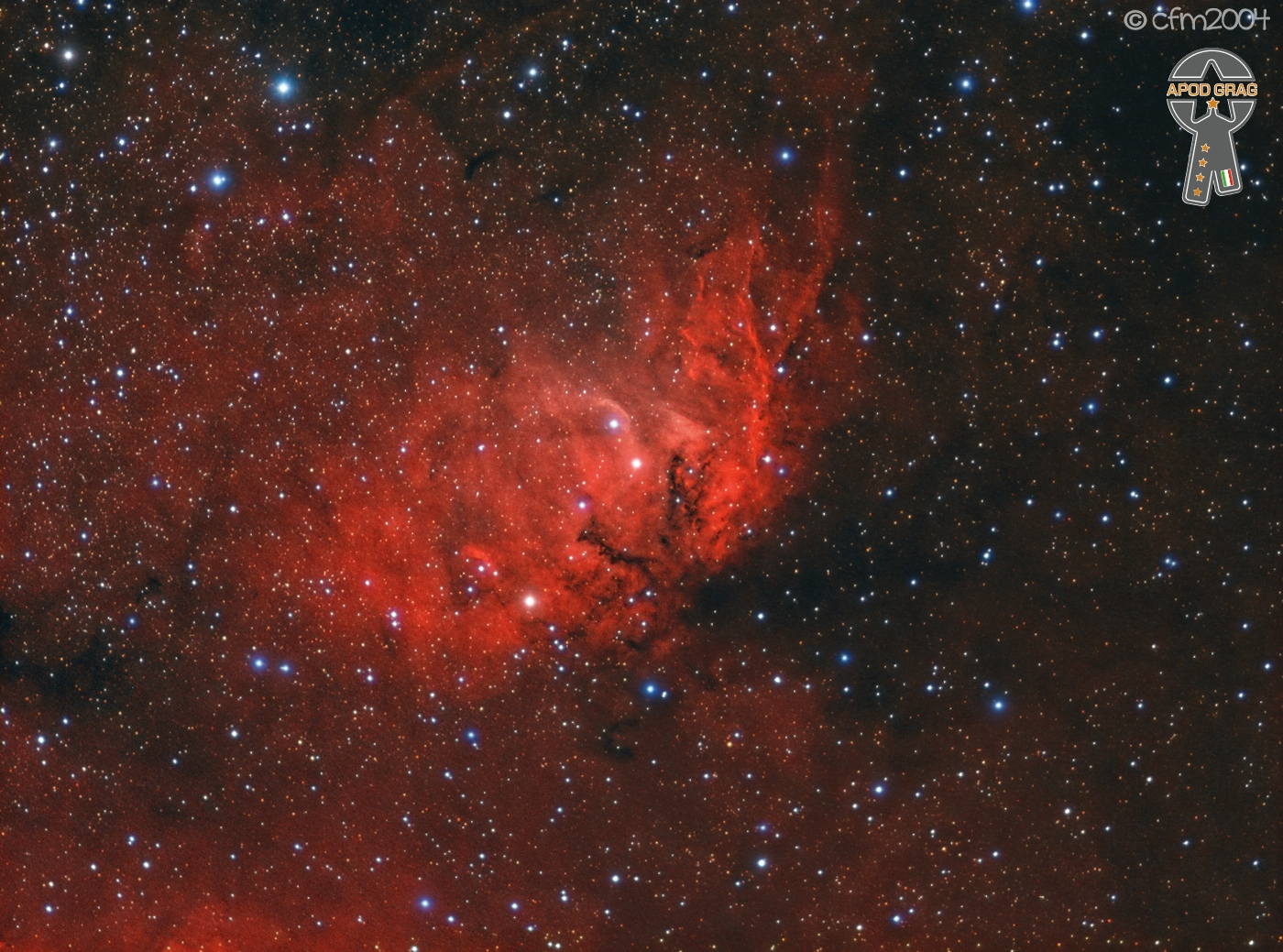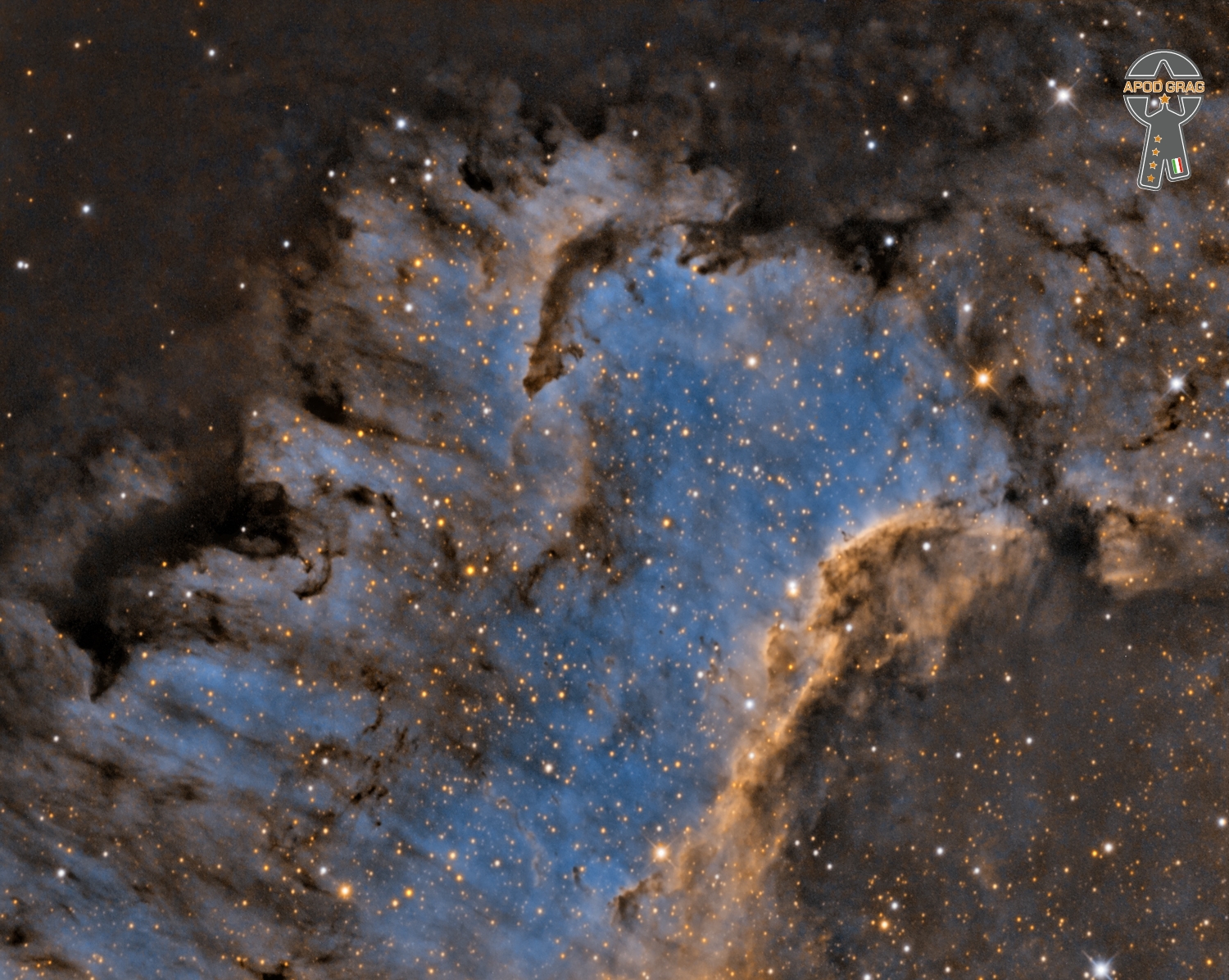Blog
Sharpless 101 (Sh2-101) is a H II region emission nebula located in the constellation Cygnus. It is sometimes also called the Tulip Nebula because it appears to resemble the outline of a tulip when imaged photographically. It was catalogued by astronomer Stewart Sharpless in his 1959 catalog of nebulae. It lies at a distance of about 6,000 light-years (5.7×1016 km; 3.5×1016 mi) from Earth.
Sh2-101, at least in the field seen from Earth, is in close proximity to microquasar Cygnus X-1, site of one of the first suspected black holes. Cygnus X-1 is located just out of the field of view of the photo in the infobox. The companion star of Cygnus X-1 is a spectral class O9.7 Iab supergiant with a mass of 21 solar masses and 20 times the radius of the Sun. The period of the binary system is 5.8 days and the pair is separated by 0.2 astronomical units. The black hole has a mass of 15 solar masses and a Schwarzschild radius of 45 km.

Howard Duane Allman (November 20, 1946 – October 29, 1971) was an American rock guitarist, session musician, and the founder and original leader of the Allman Brothers Band.
Born in Nashville, Tennessee, Allman began playing the guitar at age 14. The Allman Brothers Band were formed in Jacksonville, Florida in 1969, and achieved its greatest success in the early 1970s. Allman is best remembered for his brief but influential tenure in the band and in particular for his expressive slide guitar playing and inventive improvisational skills. A sought-after session musician both before and during his tenure with the band, Duane Allman performed with such established stars as King Curtis, Aretha Franklin, Herbie Mann, Wilson Pickett, and Boz Scaggs. He also contributed greatly to the 1970 album Layla and Other Assorted Love Songs, by Derek and the Dominos. He died following a motorcycle crash in 1971, at the age of 24.
In 2003, he was ranked number 2 in Rolling Stone magazine’s list of the 100 greatest guitarists of all time, second only to Jimi Hendrix. In 2011, he was ranked number 9. His guitar tone (achieved with a Gibson Les Paul and two 50-watt bass Marshall amplifiers) was named one of the greatest of all time by Guitar Player. Duane Allman’s skills as a guitarist were complemented by personal qualities such as his intensity, drive and ability to draw the best out of others in making music. He is still referred to by his nickname “Skydog”. Allman was killed in a motorcycle crash shortly after the release and initial success of At Fillmore East.
On October 29, 1971, while the band was on a break from touring and recording, Allman was riding his Harley-Davidson Sportster motorcycle at high speed on Hillcrest Avenue, in the western part of Macon. As he approached Bartlett Street, a flatbed boom truck stopped suddenly in the intersection, forcing him to swerve sharply. He struck either the back of the truck or the ball on the crane and was thrown from the motorcycle, which landed on top of him and skidded another 90 feet (27 m) with him pinned underneath it, crushing his internal organs. He was alive when he was taken to a hospital, but despite immediate medical treatment, he died several hours later from massive internal injuries.
more...
Meredith Jane Monk (born November 20, 1942) is an American composer, performer, director, vocalist, filmmaker, and choreographer.
From the 1960s onwards, Monk has created multi-disciplinary works which combine music, theatre, and dance, recording extensively for ECM Records.[1] In 1991, Monk composed Atlas, an opera, commissioned and produced by the Houston Opera and the American Music Theater Festival. Her music has been used in films by the Coen Brothers (The Big Lebowski, 1998) and Jean-Luc Godard (Nouvelle Vague, 1990 and Notre musique, 2004). Trip hop musician DJ Shadow sampled Monk’s “Dolmen Music” on the song “Midnight in a Perfect World.” In 2015, she was awarded the National Medal of Arts by President Barack Obama.
more...Clifton “Skeeter” Best (November 20, 1914 – May 27, 1985) was an American jazz guitarist.
Best played in Philadelphia from 1935 to 1940, recording with Slim Marshall and Erskine Hawkins. In 1940, he joined Earl Hines‘s orchestra, playing with him until he joined the U.S. Navy in 1942. After the war, he played with Bill Johnson from 1945 to 1949. He toured East Asia with Oscar Pettifordin 1951 and 1952, and formed his own trio in the 1950s. He did a critically acclaimed session with Ray Charles and Milt Jackson in 1957 called Soul Brothers.
In 1958, he recorded with Mercer Ellington and taught in New York City. He also recorded with Harry Belafonte, Etta Jones, Nellie Lutcher, Milt Hinton, Osie Johnson, Paul Quinichette, Jimmy Rushing, Sonny Stitt, Charles Thompson, and Lucky Thompson.
more...Performing for “Shabbat for the Soul” Friday service at Mt Zion Temple
more...In visible light the stars have been removed from this narrow-band image of NGC 281, a star forming region some 10,000 light-years away toward the constellation Cassiopeia. Stars were digitally added back to the resulting starless image though. But instead of using visible light image data, the stars were added with X-ray data (in purple) from the Chandra X-ray Observatory and infrared data (in red) from the Spitzer Space Telescope. The merged multiwavelength view reveals a multitude of stars in the region’s embedded star cluster IC 1590. The young stars are normally hidden in visible light images by the natal cloud’s gas and obscuring dust. Also known to backyard astro-imagers as the Pacman Nebula for its overall appearance in visible light, NGC 281 is about 80 light-years across.

Bat-Sheva Ofra Haza-Ashkenazi, known professionally as Ofra Haza (Hebrew: עפרה חזה; 19 November 1957 – 23 February 2000), was an Israelisinger, actress and Grammy Award-nominated recording artist, commonly known in the Western world as “The Israeli Madonna“, or “Madonna of the East”. Her voice has been described as a “tender” mezzo-soprano.
Of Yemenite-Jewish heritage, Haza’s music is known as a mixture of traditional and commercial singing styles, fusing elements of Eastern and Western instrumentation, orchestration and dance-beat. She became successful in Europe and the Americas; during her singing career, she earned many platinum and gold discs. In Israel, Haza was an influential cultural figure who helped to popularize Mizrahi culture.
Bat-Sheva Ofra Haza was born in Tel Aviv, Israel, to Mizrahi Jewish parents from Yemen who immigrated to Israel. She was the youngest of nine children (six sisters and two brothers) to Yefet and Shoshana Haza. They were raised in a Masorti household in the Hatikva Quarter, then an impoverished neighborhood of Tel Aviv.
more...Kenny Werner (born November 19, 1951) is an American jazz pianist, composer, and author.
Born in Brooklyn, New York, on November 19, 1951 and then growing up in Oceanside, Long Island, Werner began playing and performing at a young age, first appearing on television at the age of 11. Although he studied classical piano as a child, he enjoyed playing anything he heard on the radio and improvisation was his true calling. In high school and his first years of college he attended the Manhattan School of Music as a classical piano major.
His aptitude for improvisation led him to the Berklee College of Music in 1970, where he met and studied with his first piano/spiritual teacher, Madame Chaloff. From Boston, Werner traveled to Brazil with the saxophonist Victor Assis Brasil. There he met Assis’s twin brother, Brazilian pianist Joao Assis Brasil. His studies with Joao and Madame Chaloff would lead to the writing of the book Effortless Mastery.
more...“Alegrías” is a festive flamenco style that belongs to “cantiñas” group (cantes de Cádiz).
Its copla or stanza is usually composed by four octosyllabic verses. This is also called “alegría” stanza. Its melody is festive and incites to dance it. Its rhythm is influenced by “soleá” metric but in a more quickly way.
It seems that this style comes from Navarre-Aragon “jota” and was established in Cádiz in french occupation and “Cortes de Cádiz” time. That’s the reason why its classic lyrics refers to Ebro river, “Virgen del Pilar” and Navarre.
It is widely believed that Enrique Buitrón was the one who set the current flamenco style of “alegrías” and Ignacio Espeleta who introduced the characteristic “tiriti, tran, tran …” This “palo” has been interpreted by well-known artists: Enrique Mellizo, “Pinini” Pericón de Cadiz, La Perla de Cadiz, Chato de la Isla, Aurelio Selles, “El Folli” and Chano Lobato.
more...The North America Nebula (NGC 7000 or Caldwell 20) is an emission nebula in the constellation Cygnus, close to Deneb (the tail of the swan and its brightest star). The shape of the nebula resembles that of the continent of North America, complete with a prominent Gulf of Mexico.
On October 24, 1786, William Herschel observing from Slough, England, noted a “faint milky nebulosity scattered over this space, in some places pretty bright.” The most prominent region was catalogued by his son John Herschel on August 21, 1829. It was listed in the New General Catalogue as NGC 7000, where it is described as a “faint, most extremely large, diffuse nebulosity.”
In 1890, the pioneering German astrophotographer Max Wolf noticed this nebula’s characteristic shape on a long-exposure photograph, and dubbed it the North America Nebula.

Cindy Blackman Santana (born November 18, 1959), sometimes known as Cindy Blackman, is an American jazz and rock drummer. Blackman has recorded several jazz albums as a bandleader and has performed with Pharoah Sanders, Sonny Simmons, Ron Carter, Sam Rivers, Cassandra Wilson, Angela Bofill, Buckethead, Bill Laswell, Lenny Kravitz, Joe Henderson and Joss Stone.
Born November 18, 1959, in Yellow Springs, Ohio, her mother and grandmother were classical musicians and her uncle a vibist. When Cindy was a child, her mother took her to classical concerts.
Blackman’s introduction to the drums happened at the age of seven in her hometown of Yellow Springs, Ohio. At a pool party at a friend’s house she saw a drum set and began playing them. “Just looking at them struck something in my core, and it was completely right from the second I saw them”, says Blackman. “And then, when I hit them, it was like, wow, that’s me.”. Soon after, Blackman began playing in the school band and persuaded her parents to get her toy drums.
When Blackman was 11, she moved to Bristol, Connecticut and studied at the Hartt School of Music in Hartford, Connecticut. Blackman began to have an interest in jazz at age 13 after listening to Max Roach and got her first professional drum set at 14.
Blackman moved to Boston to study at the Berklee College of Music with Alan Dawson, who had also taught Tony Williams—an inspiration for Blackman. While she was at Berklee a friend recommended her for a gig with The Drifters so Blackman left college after three semesters and moved to New York City in 1982.
https://www.youtube.com/watch?v=uwhWbOLztDI
more...Donald Eugene Cherry (November 18, 1936 – October 19, 1995) was an American jazz trumpeter. Cherry had a long association with free jazzsaxophonist Ornette Coleman, which began in the late 1950s. He also performed alongside musicians such as John Coltrane, Charlie Haden, Sun Ra, Ed Blackwell, the New York Contemporary Five, and Albert Ayler.
In the 1970s, Cherry became a pioneer in world fusion music, drawing on traditional African, Middle Eastern, and Hindustani music. He was a member of the ECM group Codona, along with percussionist Naná Vasconcelos and sitar and tabla player Collin Walcott. AllMusic called him “one of the most influential jazz musicians of the late 20th century.”
Cherry was born in Oklahoma City, Oklahoma, to a mother of Choctaw descent and an African-American father. His mother and grandmother played piano and his father played trumpet. His father owned Oklahoma City’s Cherry Blossom Club, which hosted performances by Charlie Christian and Fletcher Henderson. In 1940, Cherry moved with his family to Los Angeles, California. He lived in the Watts neighborhood, and his father tended bar at the Plantation Club on Central Avenue, which at the time was the center of a vibrant jazz scene. Cherry recalled skipping school at Fremont High School in order to play with the swing band at Jefferson High School. This resulted in his transfer to Jacob Riis High School, a reform school,where he first met drummer Billy Higgins.
more...Máximo Francisco Repilado Muñoz Telles (18 November 1907 – 13 July 2003), known professionally as “Compay Segundo“, was a Cuban trovaguitarist, singer and composer.
Compay (meaning compadre) Segundo, so called because he was always second voice in his musical partnerships, was born in Siboney, Cuba, and moved to Santiago de Cuba at the age of nine. His first engagement was in the Municipal Band of Santiago de Cuba, directed by his teacher, Enrique Bueno. In 1934, after a spell in a quintet, he moved to Havana, where he also played the clarinet in the Municipal Band. He also learned to play the guitar and the tres, which became his usual instruments. Compay Segundo also invented the armónico, a seven-stringed guitar-like instrument, to fill the harmonic jump between the Spanish guitar and the tres. In the 1950s he became well known as the second voice and tres player in Los Compadres, a duo he formed with Lorenzo Hierrezuelo in 1947.
Los Compadres were one of the most successful Cuban duos of their time. Greater international fame came later, in 1997, with the release of the Buena Vista Social Club album, a hugely successful recording which won several Grammy awards. Compay Segundo appeared in the Wim Wenders film of the same title
more...Ignacy Jan Paderewski (Polish: [iɡˈnatsɨ ˈjan padɛˈrɛfskʲi]; 18 November [O.S. 6 November] 1860 – 29 June 1941) was a Polish pianist and composerwho became a spokesman for Polish independence. In 1919, he was the new nation’s Prime Minister and foreign minister during which he signed the Treaty of Versailles, which ended World War I.
A favorite of concert audiences around the world, his musical fame opened access to diplomacy and the media, as possibly did his status as a freemason, and charitable work of his second wife, Helena Paderewska. During World War I, Paderewski advocated an independent Poland, including by touring the United States, where he met with President Woodrow Wilson, who came to support the creation of an independent Poland in his Fourteen Points at the Paris Peace Conference in 1919, which led to the Treaty of Versailles.
Shortly after his resignations from office, Paderewski resumed his concert career to recoup his finances and rarely visited the politically chaotic Poland thereafter, the last time being in 1924.
more...More Posts
- World Music with Paco De Lucia
- Daily Roots with Alton Ellis & the Heptones
- The Cosmos with Sharpless 2-106
- John Medeski Day
- David Honeyboy Edwards Day
- World Music with Odpoczno
- Daily Roots with Ras Tweed
- The Cosmos with M8
- Johnny “Big Moose” Walker Day
- Elmo Hope Day
- Shad Collins Day
- World Music with Eleftheria Arvanitaki
- Daily Roots with Israel Vibration
- The Cosmos with NGC 1187
- Reggie Workman Day
- Big Bill Broonzy Day
- World Music with Very Be Careful
- Daily Roots with Uwe Banton
- The Cosmos with M20
- Joe Chambers Day

